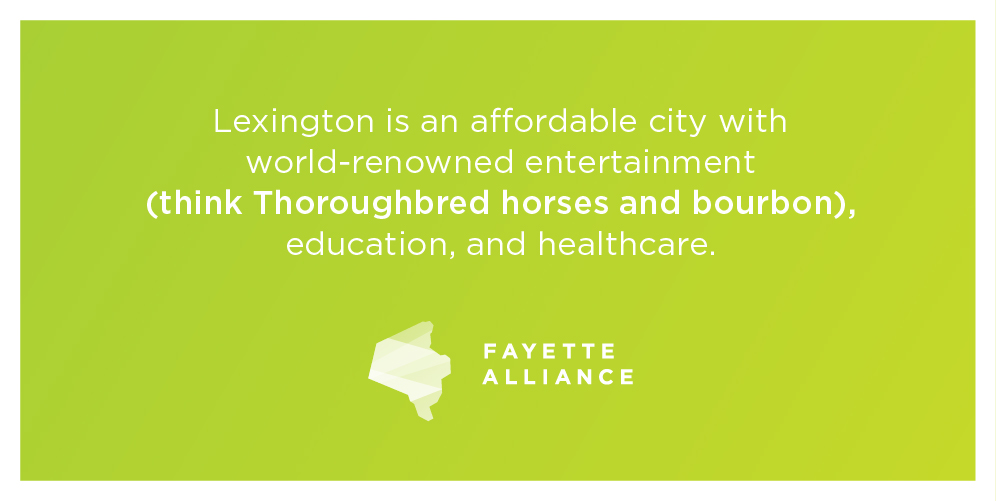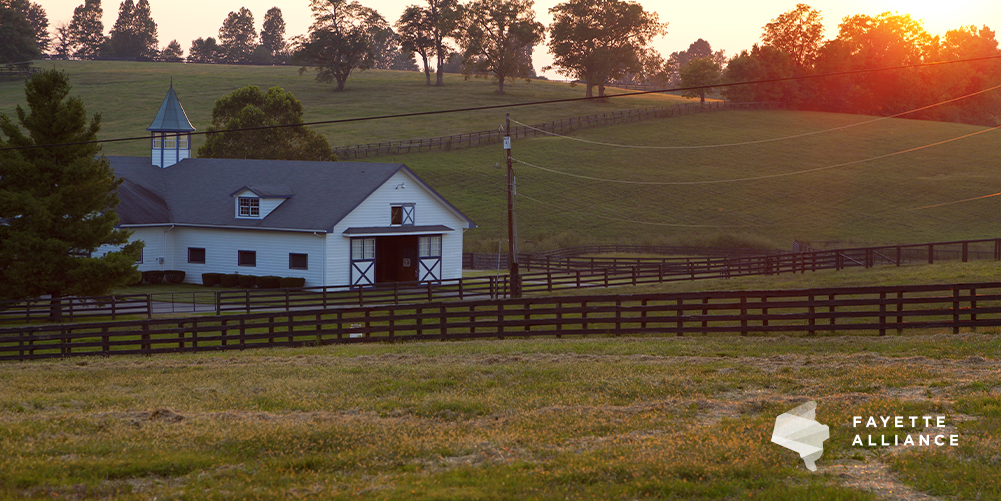The Future of Lexington-Fayette County: Bringing the 2045 Comprehensive Plan Into Focus
The creation of the Lexington-Fayette County Urban Service Boundary in 1958 established a blueprint for growth in this area of the Bluegrass region. This initiative aimed to stop unchecked urban and suburban sprawl, manage infrastructure costs, and to maintain the thriving rural business and residential communities that make up the areas surrounding Lexington. Over the years, this focus on intentional growth has allowed for a strong balance to exist between urban and rural areas, forming the basis of our high quality of life and unique identity.
What’s in the 2018 Comprehensive Plan?
The 2018 Comprehensive Plan builds on the foundation of the Urban Service Boundary and was adopted by the Planning Commission in February 2019 after 10,000 residents provided input. The focus was on creating a more equitable community for everyone by improving jobs and the economy, the environment, and neighborhoods while achieving a strong urban/rural balance within Lexington-Fayette County. The 2045 Comprehensive Plan is based on the 2018 plan with modifications based on public input in 2022 via On the Table from thousands of residents.

Jobs and Economy
Lexington often shows up on the best places to live, work, and retire lists by publications across the country. It is an affordable city with world-renowned entertainment and tourism (think horses and bourbon), education, and healthcare. With a metro area of just over half a million people, there is plenty of incentive to build economic growth and increase affordable housing options. The 2018 Comprehensive Plan outlines three pillars needed for creating a future Lexington that is livable, diverse, and prosperous:
- Livability – encouraging agritourism, expanding rural access, increasing recreational sports and greenspaces, building affordable housing options, and encouraging the creation of inclusive live/work communities
- Diversity – promoting businesses, enabling upward mobility, providing support for women and minority-owned businesses, and updating ordinances to allow for more people to work from home
- Prosperity – focus on hiring local talent, applying for agricultural grants, increasing access to broadband internet, filling vacant office spaces, and expanding job opportunities
The Environment
Improving Lexington-Fayette County’s environment is also a major concern of the 2018 plan. The state of the environment is one indicator of the overall health of a city and its inhabitants. While increased awareness of the impact humans have on water, air, land, and food production has led to positive changes, there are more improvements to be made. These goals are divided into three areas: protection, sustainability, and recreation.
- Protection – improving water quality, preserving undeveloped areas, conserving rural land and agriculture, creating connections with local farms, building agritourism opportunities
- Sustainability – expanding transportation infrastructure, improving access to green spaces for all, addressing traffic issues, obtaining funding for alternative energy sources, bolstering the recycling program
- Recreation – funding urban/community gardens, restoring Lexington’s urban forests by investing in tree-planting, supporting clean-air initiatives
Improving Neighborhoods
Ask anyone what makes a city feel like home and they will inevitably include the feel of their neighborhood. They will talk about the barista at their local coffee shop who knows their order by heart, the yoga studio all their friends go to, and the restaurants and shops that make the area unique. None of this happens by accident. Neighborhoods are in constant flux and require constant intention to maintain. The most important elements for this balance include design, density, and equity, according to the 2018 plan.
- Design – promoting aesthetics over utility when possible, balancing needs of pedestrians and drivers, developing greenspace in neighborhoods, expanding housing options (think missing middle housing)
- Density – developing housing downtown and along major roadways, easing restrictions on building Accessory Dwelling Units, creating small-footprint, single-family homes
- Equity – ensuring housing options for people with a variety of incomes, adding to senior housing by building more Accessory Dwelling Units, increasing accessibility with Universal Design, safeguarding affordable housing by enforcing building code
Creating an Urban/Rural Balance
One of the attractions of living and working in Lexington is the surrounding beautiful and productive farmland that makes Lexington unique. Connecting with nature is always within reach. Conversely, rural areas are just a short drive away from a lively city with a lot to offer local and day visitors, as well as tourists from around the world. These two worlds exist in a delicate balance, one that takes thoughtful planning and continual adjustment to maintain. The 2018 plan accounts for these tasks through its focus on accountability, stewardship, and growth.
- Accountability – ongoing discussions on best land-use practices, updating zoning guidance recommendations, creating a clear-growth plan, developing local leaders through nontraditional outreach
- Stewardship – cataloging and conserving Lexington’s stone and wooden fences and surrounding rural areas, assembling a comprehensive and diverse transportation system, working with local and regional communities to increase tourism
- Growth – encouraging downtown development, retaining cultural landmarks while expanding new project opportunities, encouraging accessible housing creation, committing to redevelopment opportunities

Building a Better Community
Lexington is beloved by many residents for maintaining a small-town feel within a major city. There are many reasons to appreciate Lexington, and it is vital to continue to build upon the strengths that make this city a great place to live and work. The 2018 plan identifies three areas of focus: connectivity, placemaking, and support.
- Connectivity – developing streets that are accessible to different modes of transportation, matching roadway composition to the desired speed limit, laying the groundwork for accessible public transportation
- Placemaking – creating a more walkable Lexington, increasing suburban community spaces, offering more public art spaces, helping local communities develop placemaking initiatives
- Support – supporting schools as a part of the local community, robust broadband network for all, increasing local health care access, ensuring transportation options to social services and community centers
Read the full 2018 Comprehensive Plan for more information on what is in store for Lexington’s future.
What are the Goals and Objectives for the 2045 Plan?
The goals and objectives of the 2045 comprehensive plan were released in January 2023 and build on the concerns of the 2018 plan with an increased focus on improving equity and environmental protections throughout Lexington over the next 20 years. Goals and objectives from the original 2018 plan have been modified, added, and/or deleted to account for changes since it was drafted and to make room for new visions for Lexington’s future. The equity changes were informed by LFUCG’s Commission for Racial Justice and Equality recommendations and from On the Table, where thousands of Lexingtonians provided input on the Comp Plan in Spring 2022.
Improvements in Equity
- The Mayor’s Commission for Racial Justice and Equality has outlined several changes that need to be made for a more equitable Lexington. This starts by understanding all residents are stakeholders of the future of Lexington regardless of their economic, racial, housing, age, or other statuses that have traditionally been excluded from these types of discussions. Some of the proposed changes include:
- Focusing on anti-racist policies in land development and use
- Addressing long-standing issues of segregation
- Expanding affordable housing options
- Creating job opportunities
- Increasing public engagement
- The mission of the Neighborhoods in Transition Task Force is “to identify ways to protect vulnerable residents from the consequences of neighborhood redevelopment and transformation, especially displacement, with an emphasis on preserving the history and the culture of communities.” They hope to accomplish this by:
- Educating residents on types of available housing and local neighborhood history
- Developing sustained communication between developers and residents
- Disseminating information about resources already in place
- Creating policies and programs to empower communities
Improvements in Environmental Protections
- Public input/meetings have been held and some of the suggested improvements include:
- Promoting the creation of and access to community greenspaces
- Integrating educational & community facilities, thereby reducing the need for transportation to/from these places
- Water quality and environmental services feedback include:
- Improving sewer systems & monitoring stormwater runoff
- Protecting essential watersheds to increase water quality
- Stimulating sustainable building through incentives
- Understanding the local environmental effects of climate change
The creation of the 2045 Comprehensive Plan is still in process and members of the general public can get involved in imagining Lexington’s future together. The Comprehensive Plan is revised every five years, and a Planning Commission public hearing will be held on Thursday, February 16, 2023, at 1:30 pm in Council Chambers at City Hall, 200 E. Main St. Recommendations will then be sent on to the Urban County Council for a vote, at which point the goals and objectives of the 2045 comprehensive plan will be finalized.

